Friday, June 29
• The waning gibbous Moon rises in the east-southeast in late twilight. An hour later, watch for Mars to clear the horizon about a fist at arm's length to the Moon's lower right (for North America).
Saturday, June 30
• By late evening the Moon and Mars are arisen together, low in the east-southeast.
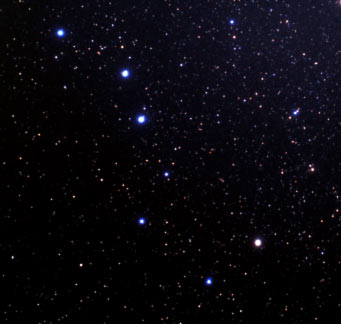
Sunday, July 1
• The Big Dipper, high in the northwest after dark, is beginning to turn around to "scoop up water" through the evenings of summer and early fall.
Monday, July 2
• Ganymede, Jupiter's biggest moon, crosses Jupiter's face tonight from 8:35 to 10:21 p.m. EDT, distantly followed by its tiny black shadow much later: from 12:58 to 2:42 a.m. EDT (when Jupiter is getting low or setting for Easterners). Meanwhile, Jupiter's Great Red Spot should transit the planet's central meridian around 9:48 p.m. EDT.
Tuesday, July 3
• If you have a dark enough sky, the Milky Way now forms a magnificent arch high across the whole eastern sky after nightfall is complete. It runs all the way from below Cassiopeia in the north-northeast, up and across Cygnus and the Summer Triangle in the east, and down behind Saturn and the spout of the Sagittarius Teapot in the south.
Wednesday, July 4
• Tonight, users of large telescopes in the Americas can watch for Saturn and especially its rings occulting a 10th-magnitude star from about midnight to 3 a.m. EDT (dusk to midnight PDT). The star is likely to show rapid fadings and dimmings as it passes behind the rings due to their filamentary fine-scale structure — if it's not totally swamped by their light! Extremely sharp atmospheric seeing will be crucial to the star's visibility. See the June Sky & Telescope, page 50.
Thursday, July 5
• Last-quarter Moon tonight (exact at 3:51 a.m. July 6th EDT). The Moon rises around 1 a.m. between Pisces and Aquarius, in the dim "Great Water" region of constellations. The Moon hangs high in the southeast by sunrise on the 6th.
• The moonless late nights for the next week are a fine time to go hunting for the little-known deep-sky objects in the Cygnus Milky Way, near Albireo, that Ken Hewett-White describes in his "Going Deep" column in the July Sky & Telescope, page 58. Cygnus is climbing high.
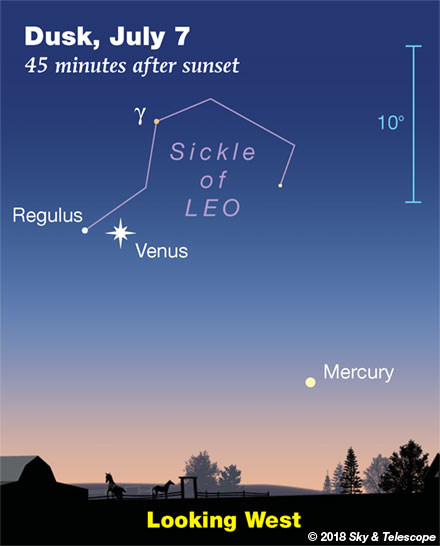
Friday, July 6
• Three doubles at the top of Scorpius. The head of Scorpius — the nearly vertical row of three stars upper right of Antares — stands due south after dark, about two fists at arm's length to the left of bright Jupiter. The top star of the row is Beta (ß) Scorpii or Graffias, a fine double star for telescopes.
Just 1° below or lower left of it (a fingertip at arm's length) is the very wide naked-eye pair Omega1 and Omega2 Scorpii, not quite vertical. Binoculars show their slight color difference.
Upper left of of Beta by 1.6° is Nu Scorpii (Jabbah), another fine telescopic double. High power in good seeing reveals that Nu's brighter component is itself a close binary, separation 2 arcseconds.
• Earth is at the aphelion of its orbit today, its farthest from the Sun for the year, 3% farther than at perihelion in January.
Saturday, July 7
• After dark, Altair shines in the east-southeast. It's the second-brightest star in the eastern sky, after Vega high to its upper left. Above Altair by a finger-width at arm's length is little orange Tarazed. And a bit more than a fist-width lower left of Altair is little Delphinus, the Dolphin, leaping leftward.
________________________
Want to become a better astronomer? Learn your way around the constellations! They're the key to locating everything fainter and deeper to hunt with binoculars or a telescope.
This is an outdoor nature hobby. For an easy-to-use constellation guide covering the whole evening sky, use the big monthly map in the center of each issue of Sky & Telescope, the essential guide to astronomy.

Once you get a telescope, to put it to good use you'll need a detailed, large-scale sky atlas (set of charts). The basic standard is the Pocket Sky Atlas (in either the original or Jumbo Edition), which shows stars to magnitude 7.6.
Next up is the larger and deeper Sky Atlas 2000.0, plotting stars to magnitude 8.5; nearly three times as many. The next up, once you know your way around, is the even larger Uranometria 2000.0 (stars to magnitude 9.75). And read how to use sky charts with a telescope.
You'll also want a good deep-sky guidebook, such as Sue French's Deep-Sky Wonders collection (which includes its own charts), Sky Atlas 2000.0 Companion by Strong and Sinnott, or the bigger Night Sky Observer's Guide by Kepple and Sanner.
Can a computerized telescope replace charts? Not for beginners, I don't think, and not on mounts and tripods that are less than top-quality mechanically (meaning heavy and expensive). And as Terence Dickinson and Alan Dyer say in their Backyard Astronomer's Guide, "A full appreciation of the universe cannot come without developing the skills to find things in the sky and understanding how the sky works. This knowledge comes only by spending time under the stars with star maps in hand."
This Week's Planet Roundup
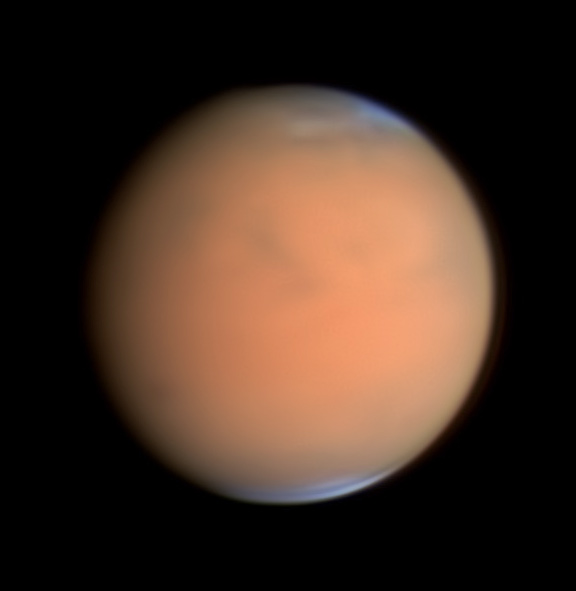
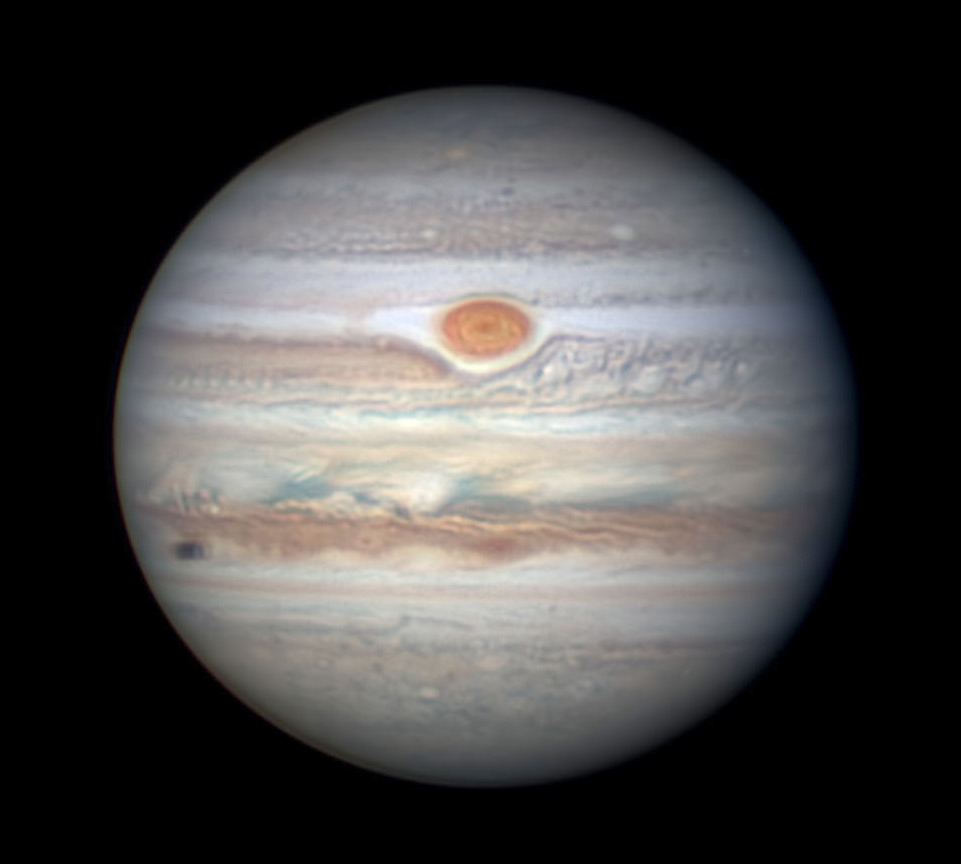
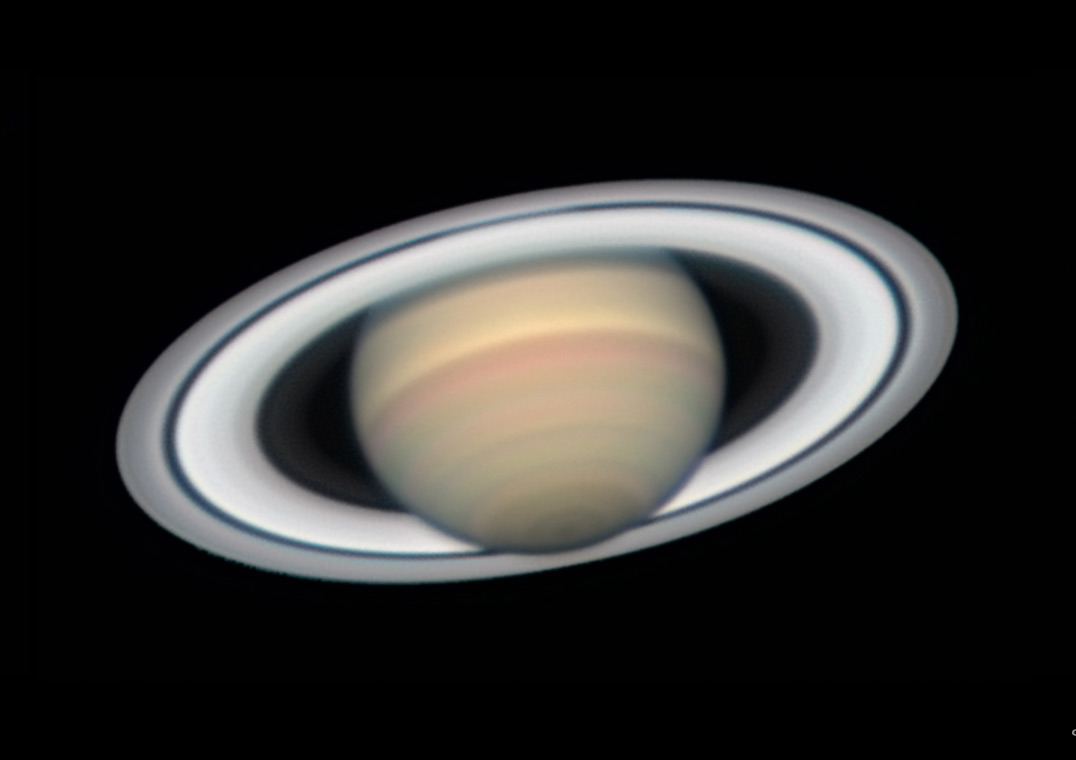
Mercury (magnitude 0.0) is visible in bright twilight very low in the west-northwest, about 16° lower right of Venus. Catch Mercury in the narrow time window between when the sky is still too bright and when Mercury sinks too low and sets.
Venus (magnitude –4.1, in Leo) shines brightly in the west during twilight. Find Regulus ever closer to Venus's left or upper left. They close from 11° apart on June 29th to 3½° apart on July 6th. In a telescope Venus is a gibbous disk 16 arcseconds tall and 70% sunlit.
Mars is the "star" planet of the summer! It's now a dramatic, Jupiter-bright magnitude –2.2, rising in Capricornus around the end of twilight. Mars is highest in the south, in best telescopic view, in the hour or so before the first light of dawn. It's 21 arcseconds in diameter, on its way to 24.3 arcseconds around its closest approach on the night of July 30-31.
But Mars is in the throes of a great dust storm! Dust has enveloped much of the planet, obscuring many major dark surface features and reducing contrast for the rest. "The planet is unrecognisable," wrote imager Damian Peach on June 26th. Dust like this remains in Mars's atmosphere for a long time. See our article Big Dust Storm Blows up on Mars, updated several times.
Can you identify any of the usual markings as seen in your scope? You'll want a Mars map that shows which features are facing Earth at your time and date, such as our Mars Profiler online.
Vesta, the brightest asteroid, was at opposition June 19th and is still unusually bright, fading from magnitude 5.6 to 5.8 this week. That's about as bright as Uranus. Vesta is west of Saturn, moving from Sagittarius into Ophiuchus. Article with finder charts: Vesta Gets Close and Bright.
Jupiter (magnitude –2.4, in Libra) shines in the south-southwest in twilight and declines in the southwest later in the evening. It's 41 arcseconds wide and shrinking. See our telescopic guide to observing Jupiter in the May Sky & Telescope, page 48.
Saturn (magnitude 0.0, just above the Sagittarius Teapot) glows in the southeast in twilight and higher in the south by midnight. It's 34° to the upper right of much brighter Mars.
Uranus (magnitude 5.8, at the Aries-Pisces border) and Neptune (magnitude 7.9, in Aquarius) are up in the east and southeast, respectively, before the beginning of dawn. Finder charts for Uranus and Neptune.
______________________
All descriptions that relate to your horizon — including the words up, down, right, and left — are written for the world's mid-northern latitudes. Descriptions that also depend on longitude (mainly Moon positions) are for North America.
Eastern Daylight Time (EDT) is Universal Time (also called UT, UTC, GMT, or Z time) minus 4 hours.
______________________
"Remember to look up at the stars and not down at your feet. Try to make sense of what you see and wonder about what makes the universe exist. Be curious."
— Stephen Hawking, 1942–2018
______________________
"The dangers of not thinking clearly are much greater now than ever before. It's not that there's something new in our way of thinking, it's that credulous and confused thinking can be much more lethal in ways it was never before."
— Carl Sagan, 1996
______________________
"Objective reality exists. Facts are often determinable. Vaccines save lives. Carbon dioxide warms the globe. Bacteria evolve to thwart antibiotics, because evolution. Science and reason are not a political conspiracy. They are how we determine facts. Civilization's survival depends on our ability, and willingness, to do this."
— Alan MacRobert, your Sky at a Glance editor
______________________
"Facts are stubborn things."
— John Adams, 1770
 2
2








Comments
misha17
June 29, 2018 at 8:45 pm
Depending on your latitude, the earliest sunset for Northern Hemisphere viewers will occur early this viewing week for cities farther south (like Los Angeles and Miami). For cities farther north like Seattle or Denver, the latest sunset occurred this past viewing week, but the sun is only setting a minute or so earlier this week.
The earliest sunrise occurred in early June; in northern cities like Seattle the sun will already be rising 10 minutes later this week than it did in early June.
You must be logged in to post a comment.
misha17
June 29, 2018 at 8:47 pm
Oops, the first sentence should read, "Depending on your latitude, the latest sunset for Northern Hemisphere viewers will occur this viewing week ..."
You must be logged in to post a comment.
You must be logged in to post a comment.